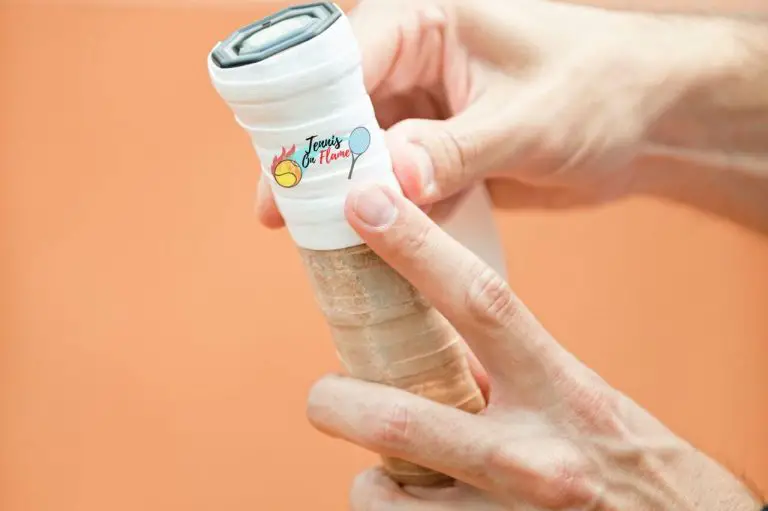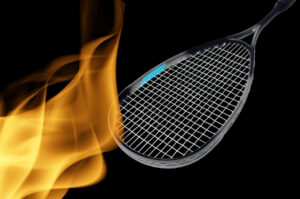If you are a tennis player, then you know that having a good grip on your racket is essential – but how do I choose a tennis griptape?
Many types of grip tape are available, so it can be difficult to decide which one is right for you.
In this article, we will discuss the different types of grip tape and help you decide which one is best for you.
What is tennis grip tape?
Tennis grip tape is a thin adhesive strip that is applied over the top of an original base grip or the replacement grip and replaced more frequently.
The purpose of grip tape is to improve your grip on the racket, which can help you control the ball better.
With grip tape, you will be more comfortable, and you’ll also have better shock absorption.
There are many different types of tennis grip tape available, so it’s important to choose one that suits your needs.

What are the different varieties of griptape?
The first thing you need to consider is the type of surface you will be playing on.
Grip tape comes in different varieties:
Tacky:
This type of grip tape is sticky and provides a good grip on the racket.
If you don’t sweat, the tacky grip is ideal for you as it becomes slippery when wet and it’s also not absorbent.
These grips are the most popular because they allow for the best possible game-play comfort.
Dry and absorbent grips:
Dry and absorbent grips are not as sticky as tacky tape but still provide a good grip.
Grip materials with dry or absorbent grips are less long-lasting, but they help those who perspire more to hold on to the racket handle better.
Anti-Vibe Tennis Racket Grip Tape:
That grip tape helps to absorb shock and vibration. This is a good choice for players who have joint pain or arthritis.
Slip-resistant:
This type of grip tape is designed for players who sweat a lot. It helps to prevent your racket from slipping out of your hand.
Perforated:
Perforated grip tape allows air to circulate, which can help keep your hand cool during play.
How do I choose a tennis grip tape?
Now that you know the different types of grip tape available, it’s time to choose one that is right for you.
Here are the factors to consider when choosing an overgrip:
Sweat absorption:
If you sweat a lot, then you will need a grip that can absorb moisture.
Dry and absorbent grips are the best choice for players who perspire more.
Durability:
You will also need to consider the durability of the grip.
Some types of grip tape are more long-lasting than others. If you play tennis frequently, then you will need a durable grip.
Thickness:
The thickness of the grip is also important.
If you want a thin grip, then choose a perforated grip. If you prefer a thicker grip, then choose an anti-vibe racket grip.
Tackiness:
The tackiness of the grip is also important to consider.
If you don’t sweat, then a tacky grip is ideal for you. If you do sweat a lot, then choose a slip-resistant grip.
Texture:
The texture of the grip is also something to consider.
Some grips are textured, while others are smooth. Choose a grip that you feel comfortable with.
By considering these factors, you will be able to choose a tennis grip tape that is right for you.
How often should I change my overgrip?
You should follow the rule, and change your overgrip per month as often as you play tennis per week.
You should change your overgrip as often as you need to maintain a comfortable grip on your racket.
If you notice that your grip is slipping or if it feels uncomfortable and if your overgrip changes its texture and appearance is time for you to replace your overgrip.
How many overgrips do you use?
I recommend limiting the number of overgrips you apply to your racquet’s handle to no more than two.
Some people prefer to use two overgrips, but it is often there is more advantageous to have a large handle rather than use two overgrips on a smaller handle.
Use a heat shrink sleeve to expand the size of your racquet handle if you want to make it larger.
Although double overgrips provide a good amount of thickness, it is essential to check that they don’t make your racket uncomfortable to hold in general.
How thick should a tennis overgrip be?
The average thickness of the overgrip should be 1/16 inch.
The thickness of the overgrip is important because it determines how much cushioning and absorbency you will get.
What overgrip do pro tennis players use?
Many pro tennis players use the Wilson Pro Comfort Overgrip.
This overgrip is a big hit on both the ATP and WTA circuits.
pro like Roger Federer uses that overgrip.
The Wilson Pro Comfort Overgrip is one of the finest tennis overgrips available.
If you are looking for a high-quality overgrip, then this is the one for you.
To purchase the Wilson Pro Comfort Overgrip, you can click here!
In conclusion
There are many factors to consider when choosing a tennis grip tape such as absorbency, durability, thickness, tackiness, and texture.
By considering these factors, you will be able to choose a grip that is right for you.
Additionally, you should change your overgrip per month as often as you play tennis per week.
I recommend limiting the number of overgrips you apply to your racquet’s handle to no more than two.
The average thickness of the overgrip should be 1/16 inch.
Many pro tennis players use the Wilson Pro Comfort Overgrip.
If you are looking for a high-quality overgrip, then this is the one for you.
Try out different types of overgrip until you find the one that is right for you.
Don’t be afraid to experiment!
The perfect grip will help you improve your game and make playing tennis more enjoyable.
I hope this article helped choose the right tennis grip tape.
Stay tuned for more posts about interesting topics in the world of tennis!
If you have any further questions, please feel free to leave a comment below. 🙂
Do you want more? check out my other blog posts for more informative guides.
Thanks for reading and happy gripping!








